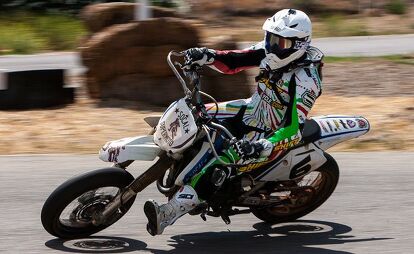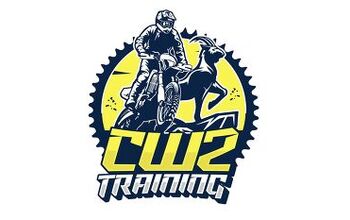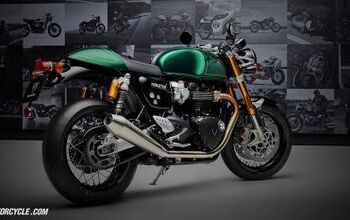SoCal SuperMoto School + Video

On the quest to back it in
We all love a little trackday fun, but the truth is they can be expensive. It’s at least a C-note to get you in, plus the early wake-up call and long drive to the track. There’s gotta be a better way. Supermotard (Superbikers if you’re really old-school) is the answer. Essentially dirtbikes with street tires, they’re virtually bulletproof, and tires last way longer. Additionally, kart tracks – where their torque-happy engines are better suited – are closer to civilization and much cheaper to enter than full-size racetracks. It was the perfect solution for Tropical Fishtank editor, Tom Roderick, and myself to spend a day outta the office.
You see, it had been a while since we had ridden Supermoto, and the itch needed to be scratched. However, motards require a unique riding style, and frankly, neither of us had much formal training in the matter. In order to give both bikes in our recent Gas vs. Electric Supermoto Shootout a fair shake, proper instruction was in order, and Brian Murray, proprietor of the SoCal SuperMoto school, which primarily runs at Adams Motorsports Park in Riverside, CA, was just the guy to give it.
Unlike most other riding schools, SoCal SuperMoto, just like the sport itself, is relatively inexpensive. Assuming all you have is gear (leathers are preferred, but MX jerseys with armor underneath is acceptable) and possess general competence on a motorcycle, $239.99 will get you signed up for the class. Included in the price is instruction, track fees, photography, and use of one of Brian’s workhorses, a Suzuki DR-Z400SM. If you have your own bike, the cost drops to $174.99, and if you’re able to play hookie from work and come on a Monday, you pay only $199.99 – a $40 savings just for skipping work to ride someone else’s bike. He’ll even throw in a t-shirt or baseball cap. Private group sessions are also available at various other locations in the Southern California area.
If you opt for the aforementioned Suzuki school bikes, you can take comfort in the fact these bikes can take a beating. The standard bike is upgraded with simple things like Dunlop Q3 tires, beefier brakes, a freer-flowing exhaust and various crash guards to protect the bike from the inevitable tipover. However, no motorcycle is immune to destruction from an overly enthusiastic student, and to that end, Murray enforces a two-crash maximum. Crash twice on the pavement and you’re done for the day. “Crashes in the dirt don’t count,” he says.
X’s and O’s
While it’s natural for a bunch of adrenaline-charged riders to want to hop on bikes straight away, Murray’s knack for teaching shows in his ability to reign everyone in and sit them down for class instruction. The overall atmosphere at a typical school is very informal, and as Tom noted during our day, “Brian is able to maintain a casual air by infusing humor and student participation into his instruction.” Group sizes typically run about 10 – 15 deep, with both genders and a mix of backgrounds. Our particular group featured first-time riders on pavement, all the way to experienced riders looking for a bit more coaching in the dirt (i.e, me).
Since students, especially motorcyclists, generally have short attention spans, Murray splits the instruction and track time into 15 minute chunks. This also works since the track is shared in 30-minute sessions with those in go-karts. The morning is spent going over basic technique, then things ramp up after lunch with the climax being a mock race staged at the end of the day.
For those like Tom and I, who are used to leaning in the direction of the turn, Supermoto riding presents a unique challenge, as its technique is counter to everything we know. Fighting those ingrained habits is the first lesson of the day. Murray’s acronym for this part of the curriculum is called BrAP. Short for “Brake, move your Ass up and to the outside of the seat, and Push the bars away.” Dirt riders will be all too familiar with the technique, but as the majority of the class came from a street background, it was an important first lesson to set in our brains immediately.
On track, the conscious effort to completely change our riding style wasn’t easy. In fact, Tom often found himself “doing the opposite of what I was instructed to do.” The same applied for me as well, but Murray made a point to tell everyone to go slower, if need be, to get the technique down. It’s never an easy thing to go slower on a track, “but forcing myself to fight against my sportbike riding habits increases the fun and challenge,” Tom said.
Another difference between SuMo and normal street riding is the shifting. Clutchless upshifts are the norm, but going down the gears is where it changes. For most people, myself included, at least partially releasing the clutch after each downshift is the norm. Murray teaches his students to brake as you normally would entering a corner, but instead pull the clutch in once, bang all the necessary downshifts, then smoothly release the lever. Getting shifts done and out of the way like this is one less thing to worry about. However, the emphasis is on “smooth.” Simply letting go of the clutch could add major unneeded drama from the back end as it locks and chatters.
Much of the morning centered around shifting and proper body positioning, two key elements to the SuMo learning experience. For each successive session, in between the karts being out on track, Murray would give tips and advice on how to go quickly around the Adams course. Those tips were secondary, however, to the main goals of proper body positioning, downshifting and overall smoothness on the motorcycle.
Throughout the day, we noticed many of the students actively applying the lessons on track. The informal structure of the day means students can come on and off the track as much as they want, and if they have questions, Murray is very accessible to give pointers in between laps. Ultimately, the DR-Z400SM proved to be a great teaching tool. Tom noted, it’s “not too fast for the beginners, yet fast enough to keep things exciting for experienced riders.”
Despite the two-crash policy, some people still went down, including an overzealous Roderick, who saw an opportunity to pass yours truly into a braking zone before running out of talent and hitting the deck. Including this fall, all of the crashes we saw were minor tip-overs, and nobody crashed twice on the pavement. Really, the only dent went to some egos, which is fortunate because there was no ambulance waiting on standby.
The action picked up after lunch when the dirt portion of Adams opened. I’ve made no secret of my poor skills in the dirt, and this was a big reason why I wanted to attend the school. On this particular day, the dirt was ultra fine, almost silt-like, and hadn’t been watered. All of the previous lessons of the day would come in handy, but ultimately, Murray’s advice was simple. “Your inputs need to be even smoother in the dirt than on pavement,” he said. “It’s the same for any surface with ultra-low traction.” Since the bikes were equipped with street tires without blocks to dig into the dirt surface, he added one more tip: “Oh, and don’t touch the front brake.”
As expected, the level of traction was incredibly diminished the moment wheels hit the dirt. Practicing proper body technique, with elbows up, chest out, butt on the opposite side and foot out saved the day on multiple occasions, as I’d dig my foot in the ground whenever the front tucked to pick it back up again.
This became especially useful during the mock race, as 15 riders of varying levels tried to occupy the same stretch of dirt at the same time. Both ends slipped, spun or tucked several times, but staying the course and remembering the earlier drills helped me remain on two wheels. Making a conscious effort to only use rear brake took some training, but rear brake slides in the dirt brought back that same juvenile happiness I used to get doing those same tricks on my BMW bike as a kid. Just remember to keep the clutch pulled so you don’t stall the engine.
It was especially interesting to see the students with dirt backgrounds relish the opportunity to finally play in their natural habitat, as the lack of traction didn’t bother them. “Definitely the dirt section was the most challenging part of the day,” Tom said. Meanwhile, catching air over the jumps was a blast. T-Rod continues, “I always love the opportunity to put some fresh air beneath the tires! Something I wouldn’t even want to attempt on a sportbike.” In the end, Tom came in second quickest of the students, while I trailed him home.
You Learn Something New Everyday
There aren’t many venues in motorcycling that give you the opportunity to reach Marc Marquez-like lean angles, ride in dirt and catch some air all at the same time. Supermoto is the exception. Both Tom and I saw a marked improvement in ourselves and the other riders throughout the day, as we learned to trust the bikes and the technique.
Of course, there’s the question many are asking: How do you back it in? To quote Murray, “If I were to give you a set of instructions on how to back it in, it would be the same as how to highside. Backing it in comes as a result of going faster, not the other way around.” Truth is, there is no magic recipe. Like any other sport, a mastery of the fundamentals will naturally progress into more advanced technique.
All Tom and I know is, at the end of our time with Murray and the SoCal Supermoto, we had fun, we learned new skills, and relatively little money was spent. It doesn’t get much better than that. Check out www.socalsupermoto.com to view the calendar and sign up for the next event.

Troy's been riding motorcycles and writing about them since 2006, getting his start at Rider Magazine. From there, he moved to Sport Rider Magazine before finally landing at Motorcycle.com in 2011. A lifelong gearhead who didn't fully immerse himself in motorcycles until his teenage years, Troy's interests have always been in technology, performance, and going fast. Naturally, racing was the perfect avenue to combine all three. Troy has been racing nearly as long as he's been riding and has competed at the AMA national level. He's also won multiple club races throughout the country, culminating in a Utah Sport Bike Association championship in 2011. He has been invited as a guest instructor for the Yamaha Champions Riding School, and when he's not out riding, he's either wrenching on bikes or watching MotoGP.
More by Troy Siahaan













































Comments
Join the conversation